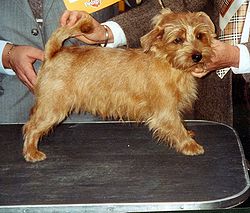Norfolk Terrier
The Norfolk Terrier is a British breed of dog. Prior to gaining recognition as an independent breed in 1960, it was a variety of the Norwich Terrier, distinguished from the "prick eared" Norwich by its "drop ears" (or folded ears). Together, the Norfolk and Norwich Terriers are the smallest of the working terriers.
Appearance
The Norfolk Terrier has a wire-haired coat which, according to the various national kennel clubs' breed standards, can be "all shades of red, wheaten, black and tan, or grizzle."
They are the smallest of the working terriers. They are active and compact, free moving, with good substance and bone. Good substance means good spring of rib and bone that matches the body such that the dog can be a very agile ratter or earth-dog.
Norfolk terriers are moderately proportioned dogs. A too heavy dog would not be agile. A too refined dog would make it a toy breed. Norfolks generally have more reach and drive and a stronger rear angulation, hence cover more ground than their Norwich cousins. Norfolk have good side gait owed to their balanced angulation front and rear and their slightly longer length of back.
The ideal height is 9 to 10 in (23 to 25 cm) at the withers and weight is about 11 to 12 lb (5.0 to 5.4 kg).
Temperament
Norfolks are described as fearless, but can be aggressive. They, along with Norwich Terriers and Border Terriers, have the softest temperaments of the Terrier Group. Norfolks work in packs and must get along with other dogs. As companions, they love people and children and do make good pets. Their activity level is generally reflective of the pace of their environment. This breed should not be kept or live outside since they thrive on human contact. Generally, Norfolks are not given to digging but, like any dog, will dig out of boredom when left alone for too long a period. Norfolks can be barkers and are very vocal. They generally cohabit well with other household pets when introduced as a puppy. Outdoors, they are natural hunters with a strong prey drive for small vermin.
Norfolks are self-confident and carry themselves with presence and importance, holding their heads and tails erect. A Norfolk that is shy or that carries its tail between its legs is atypical, as it is hot-tempered and aggressive with other dogs; these traits are not the standard. A Norfolk's typical temperament is happy, spirited, and self-confident.
Working style
Norfolks were originally bred as barn dogs to rid the barn of vermin. Some literature suggest that they were also occasionally used on the hunt to bolt animals of equal size from their den. To some extent they are still used in that capacity in continental Europe. Norfolks are pack animals and hence expected to get along with other dogs while working or in the home. As a pack dog, they take turns working their prey. They are fearless and their courage is incredible. Today, of course, they are household companions and must have an agreeable disposition for living with people.
History
In the 1880s, British sportsmen developed a working terrier of East Anglia in eastern England. The Norwich Terrier and later the drop-eared variety now known as the Norfolk Terrier, were believed to have been developed by crossing local terrier-like dogs, small, short-legged Irish Terrier breeds and the small red terriers used by theGypsy ratters of Norfolk (the county in which Norwich the city exists).
They were first called the Cantab Terrier when they became fashionable for students to keep in their rooms at Cambridge University in England. Later, they were called the Trumpington Terrier, after Trumpington Street where the breed was further developed at a livery stable. Then, just prior to World War I, a prominent Irish horse rider Frank Jones sold quantities of the short-legged terriers to the USA, so there they were called Jones Terriers. It was Jones who designated the terriers were from Norwich.
In 1932, the Norwich was granted acceptance into the English Kennel Club and the first written standard was created. The American Kennel Club registered the first Norwich Terrier in 1936. In 1964, The Kennel Club reclassified the drop-ear variety as it its own breed, the Norfolk Terrier, and the prick-eared variety retained the name Norwich Terrier. The American Kennel Club and Canadian Kennel Club both recognized the division of the Norwich Terrier breed in 1979. The Norfolk Terrier was recognized by the United Kennel Club in 1979. After many generations, these two breeds have developed as two distinct breeds both in physical looks and in temperament. Of note, there is literature that suggests that the Norfolk and Norwich were always two distinct breeds and the original mistake was classifying them as one.
 | ||||
| A Norfolk Terrier at a conformation show | ||||
| Country of origin | Great Britain | |||
|---|---|---|---|---|
| ||||
| ||||


No comments:
Post a Comment